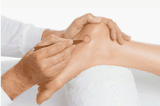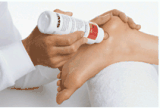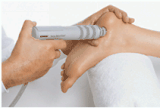The Foot
Animation of the treatment method | ||||||||
Heel Spurs Heel Spurs are changes in / calcifications of the skeleton brought about by huge local stretching strain on the periost and the skeleton structure of the heel. It can be seen on X-rays. It is not absolutely essential to remove a heel spur as part of the treatment.
Morton’s Neuroma Morton’s Neuroma is a painful nerve knot between two foot bones, usually between toes 3 and 4. Changes in the soft tissues may give an increased pressure explaining the pain. Morton’s Neuroma is found more often with people with fallen foot arches. Walking and running provoke pain that may turn out to be crippling. Wide shoes, arch support and surgery are some of the possible alternatives for treatment of Morton’s Neuroma apart from Radial Shockwave Therapy.
Plantar Fasciitis Plantar Fasciitis is a chronic pain condition caused by inflammation of the plantar fascia. The plantar fascia encapsulates muscles in the sole of the foot. It supports the arch of the foot by acting as a bowstring to connect the ball of the foot to the heel. Heel spurs are soft, bendable deposits of calcium that are the result of tension and inflammation in the plantar fascia attachment to the heel.
Causes of heel pain include inadequate flexibility in the calf muscles, lack of arch support, being overweight, suddenly increasing activity, and spending too much time on the feet. The mechanical stress may cause skeleton changes in the heel bone over time.
The tendon tissue changes that cause Plantar Fasciitis are the most common reason for athletics’ heel pain. |
Member of:















